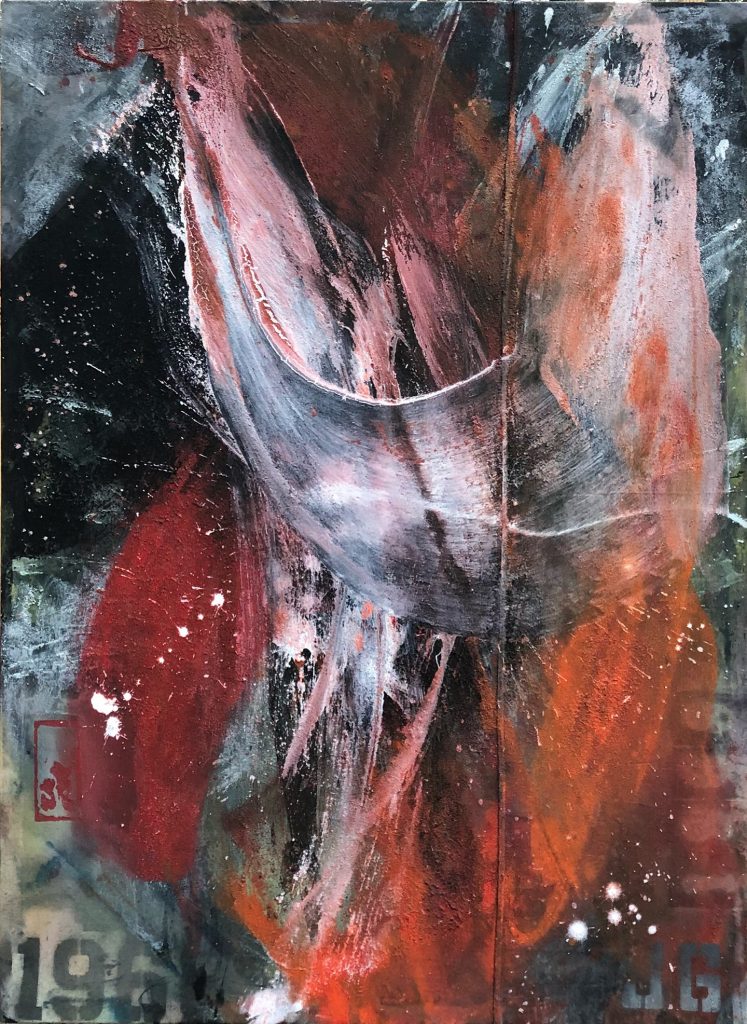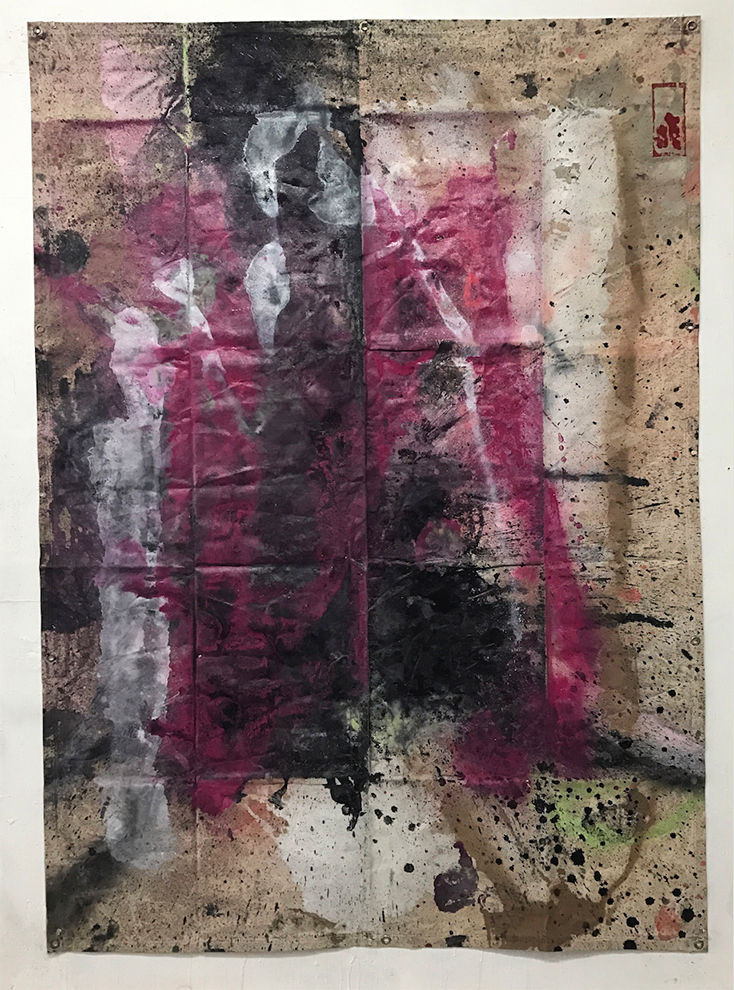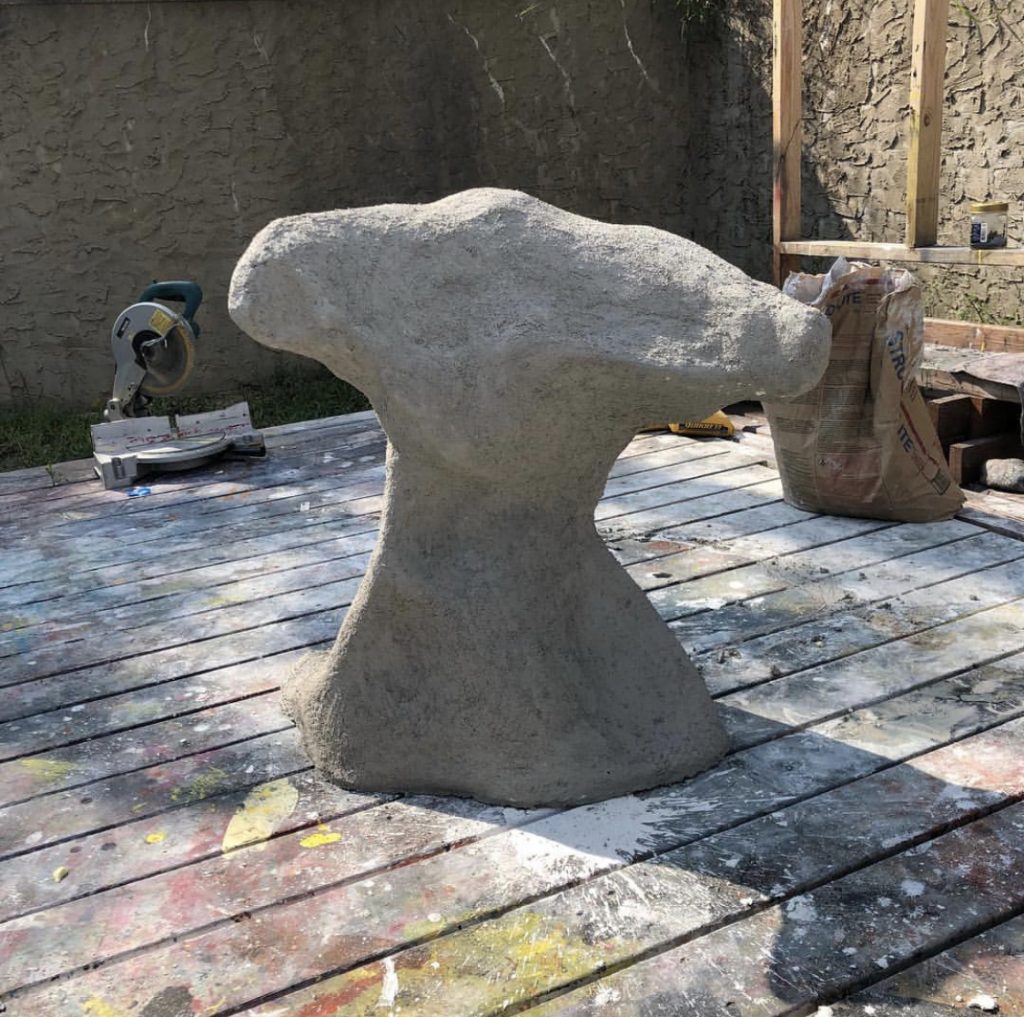Recent Work at Elga Wimmer PCC in New York City
by Siba Kumar Das

Art objects are storytelling machines. That’s because we are hardwired to tell and listen to stories. All art, no matter how abstract, must respond to this fundamental human trait.
Viewing the show (September 15-October 31, 2018) of Brooklyn-based painter and sculptor James Greco’s new work at Elga Wimmer’s Chelsea Gallery in New York, you would have been transported to narrative worlds even as you gazed at his gestural abstraction. Employing an improvisational mark making and painterly freedom that is singularly his, Greco discovers pictures that traverse the gap between the gestural and the referential.
Six tarpaulin paintings, together forming the show’s piece de resistance, were hung on the walls of the gallery’s main display space, together with two more traditionally made paintings created on cotton cloth the artist had stretched on wooden fames he himself had made. A third painting from this category was on display in an adjacent smaller space. Four sculptures were distributed between the two rooms.
At work in the paintings was the energy and effort of an embodied mind, concentrated in a painter’s hand. Greco says he has an elemental, passionate relationship with paint, and you see this in the sheer physicality he imparts to his imagery. Driving his work is an immersion in spontaneous process, not the finished product – nonetheless, the product emerges as a compelling object that reverberates in you, a hard-won image that takes you to the continuity between gesture and reference. This is akin to mindfulness. You become one with the painter’s experience, the embodied experience that created the painting.
Let’s take a look at two of the paintings in the show, starting with one of the three more traditional paintings so as to see more clearly the leap forward the tarp paintings represent. The name of the piece 1968, no.14 was initially a reference to the year in which Greco was born, and it sprang to his mind while the painting was still in process. Once this light came on, he also recalled the political and social turmoil that erupted in 1968 in many parts of the world. The clash between the grays and whites and reds of this highly energetic painting evokes a violent turbulence that makes you think of Francis Bacon’s paintings as well as Chaim Soutine’s. Coming to mind, too, is the volcanic energy and sinister violence of the paintings of some members of the Gutai group.
Greco in fact celebrates the affinity between his artistic practice and the ideas that drove the revolutionary art of these Japanese artists, who were active as a group between 1954 and 1972. When you regard his tarp paintings you see this affinity right away.
In terms of both Japanese culture and the global art world, the Gutai group sought a new beginning and aspired to a strident originality, especially with regard to choice of materials and processes. Such a radical departure was a natural response to the national disaster the Second World War brought to the Japanese people. The group wanted to turn away from the country’s past and consciously adopted an internationalist outlook. Yet, while the Gutai pioneered new ways of art making that prefigured and catalyzed such later global art forms as happenings and performance art and conceptual art, they achieved, especially in painting, an immediacy, spontaneity, and free expressiveness that was also a hallmark of traditional Japanese art inspired by Zen Buddhism. Look at Tarp Painting 14. The vitality Greco generates in it through his gestural use of wine red, black, gray, white, and earth brown pigments create in you a Zen like experience that is at once numinous and embodied. The play of the colors pushes and pulls, affecting you viscerally, pulling you into a narrative drama, while also pushing you imperceptibly via a subtle allusiveness that seems to harbor a “sudden awakening”– the very essence of Zen. For centuries Zen painters aspired to bring a painting’s core into existence through a single stroke. You see that idea pervading all of Greco’s tarp paintings.

Greco creates a grid in each tarp by folding it into squares he embeds into the canvas by using an iron. The resulting “ghostly geometry”, as he calls it, provides a structure that helps give direction to his brush strokes. Over time, the folds relax and spread out, creating undirected change. The outcome speaks to you of simplicity, artlessness, and even imperfections wrought by time and usage.
The sculptures in the show were made with the same spirit, energy and aspiration that animate his recent paintings. Made of wood, plaster, cement and resin, the forms come together rather quickly with little thought or preconception. Greco tries to feel the physical space they occupy and the independence they claim. Once realized, they are shaped with plaster or cement bringing it all into unity with the mechanical aspects of the binding process being well hidden, inclusive of the armature materials. Greco then applies resin to seal the surfaces and leaves them alone.

Elga Wimmer PCC is currently promoting a new show devoted to the abiding greatness of Asian landscape painting and the reinvention of this genre in contemporary art. Greco, now signing his paintings with a traditional Japanese-style ink stamp – this with a view to signifying not so much their origin in his hand but rather the process that brought them into being – will be a contributor.
The James Greco show discussed in this article ended in October 2018. Those seeing it would have found transformative his distinctive narrative abstraction. The signals they would have received from the liminal space his art occupies would have beckoned them into a heightened awareness.
